One of the elements of foundation protection is the blind area around the house. They are built from concrete, hard crushed stone. However, over time, the blind areas also become unusable, therefore they need protection.
Description of the blind area and device
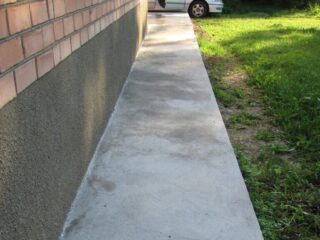
Blind area - a strip of concrete or asphalt, located around the perimeter of the house. The canvas is placed at a low angle in the direction from the building in order to divert rain or flood water from the walls.
The main task of the blind area is to protect the foundation. This part of the building is constantly in contact with the ground. During the rain, the earth is saturated with moisture, and the foundation becomes wet. It has a destructive effect on any material: concrete, bricks, piles. A concrete strip around the house removes water, the latter is also absorbed by the soil, at some distance from the foundation, which significantly reduces its wetting.
The width of the blind area reaches 90-100 cm, the angle of inclination is 3-5%.
Arrange water drain as follows:
- They dig a trench of the required size around the building. They tamp its bottom. If necessary, make a castle from clay.
- A layer of coarse or medium-sized sand is placed on the bottom. You can't take a small one, as it sits down a lot. The thickness of the layer depends on the nature of the soil: from 20 cm on stony soil to 50 cm on unstable soil.
- A layer of crushed stone is tamped onto a layer of sand.
- Formwork is mounted and reinforced with steel mesh.
- Along the entire perimeter, transverse boards are laid in increments of 2 m. They provide expansion joints.
- The formwork is poured with M300 concrete. Each section is poured in 1 reception.
Covering the blind area around the house prevents the destruction of the material under the influence of water, snow and cold. However, it does not protect against shrinkage or movement.
Causes of defects
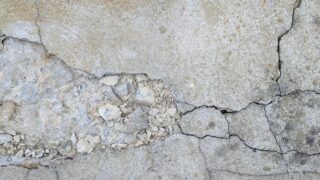
Damage to the concrete strip is expressed in the appearance of cracks, chips, delamination. At first glance, the deformation is insignificant, but along the cracks, water enters the blind area and, after freezing, destroys the stone.
The reasons are as follows:
- If there was too much water or little cement in the original concrete mixture, the material after hardening is not resistant to frost. A few winters are enough to break the canvas.
- If backfilling used soil of a lower density compared to untouched soil - sandy loam instead of loam, loam instead of clay - the soil under the walkway absorbs water better than untouched soil. Thus, the heaving of the soil is artificially increased. Under the influence of pressure from the bottom of the concrete, the strip is destroyed.
- Laying asphalt directly on the ground, without a layer of sand and gravel, is a classic mistake when installing in mid-latitudes. This technology is allowed in the southern regions, but in the northern regions, the absence of bedding and expansion joints leads to displacement of the blocks. The blind area is falling apart.
- If the canvas was built in the summer in the heat and was not saturated with water during hardening, the concrete hardens faster than it gains strength. Such material is easily destroyed.
- If there are no gutters on the roof and water drips onto the concrete path, grooves and cracks appear in it.
A variety of minor design errors lead to destruction, for example, the absence of a drainage groove, curb blocks, and a reinforcing mesh.
Blind area restoration works
Dry iron
The work is carried out 15–10 minutes after pouring, the concrete remains wet. The surface is covered with a layer of dry cement 2 mm thick. For this, the powder is sprinkled through a sieve or even gauze. Then the layer is leveled with a trowel or grater.
No more than 1 bucket of cement is required per blind area.
Wet iron
In this case, the cement is diluted with water in a 1: 1 ratio, lime dough is added - no more than 1/10 of the total volume, as well as liquid soap or PVA adhesives. The mixture is applied in the same thin layer with a spatula. Sprinklers can be used.
The surface is covered with a film, and at high temperatures it is periodically moistened. Such a coating will be ready only after 2 weeks.
Polymer iron
You can cover concrete blind areas around the house with ready-made solutions, like Spektrin, Pentra. Impregnations increase the strength of the material and prevent moisture penetration. Ironing is performed in the same way as wet. The only difference is that only metal floats can be used for work.
Polymer mixtures are more expensive than conventional cement. However, they improve the resistance of concrete to low temperatures, impart water-repellent properties to the surface. The compositions can be applied to the canvas at temperatures up to 0 C.
Using impregnation for concrete blind area
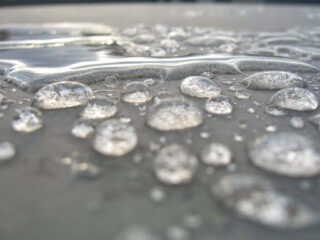
The surface of the concrete bed is quite hygroscopic. Its upper layer is prone to chipping due to the processes occurring during setting. To strengthen it and make it hydrophobic, impregnations are used.
Compositions are made most often on the basis of polymers. Such substances polymerize during drying and form a water-repellent film. Deep impregnation compounds react with lime particles and together with it transform the top layer of concrete.
Impregnations are classified according to a variety of criteria:
- Dedusting - impregnates the top layer, strengthens and prevents chipping. Such a coating is very resistant to the action of chemically aggressive substances and is more often used in production than in everyday life.
- Reinforcing is a universal option, as it improves wear resistance and increases moisture resistance, resistance to long-term loads, and increases toughness. The impregnation penetrates into the depth of the material by 3.5 mm and increases the overall durability up to the indicators of the M600 grade.
- Colored - Concrete rarely needs to be painted, but colored impregnation makes the concrete walkway attractive.
- Protective universal - like polyurethane. The substance significantly increases the strength of the top layer. A polymer film formed on the surface protects the substrate from moisture. Moreover, the polyurethane impregnation prevents capillary condensate seepage. The composition fills all microcracks and pores.
For finishing the blind area, you should not take acrylic impregnations. Otherwise, the treatment will have to be repeated every 2 years.
Rules for working with impregnations
When processing concrete with impregnations, the following recommendations are followed:
- The blind area is cleaned of dust and dirt. It is better to seal up chips and cracks with cement mortar.
- The concrete cloth is sanded with a grinder.
- Apply the solution at temperatures from +5 to +40 C. Use rollers and brushes.
- Concrete is impregnated several times: layer 2 is applied after 1 hour, 3 - 3 hours after the second.
During work, wear goggles, a protective mask or respirator, as well as gloves and an apron.
Waterproofing the concrete blind area around the house
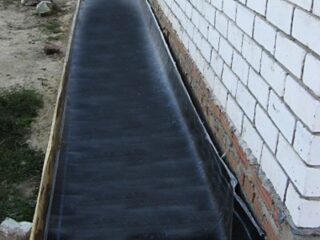
You can trim the concrete blind area around the house with waterproofing materials. They do not increase the strength of the structure, but they reliably protect against rain and snow.
Several options are used:
- Painting - bitumen mastic is applied with a roller to the canvas and leveled. When hardened, the mastic forms a durable water-repellent film.The mastic is applied in 3 layers. A definite plus: the liquid material fills cracks and chips, they do not need to be repaired first.
- Penetrating - for example, polymer impregnation fills the pores and does not allow moisture to enter the material.
- Roll - roofing material is most often used. The material is cut and laid on a blind area, on the surface of which layers of clay were previously applied.
The concrete blind area around the house protects the foundation and walls of the building from getting wet and premature destruction. However, the canvas itself needs protection, strengthening, hydrophobization, and finishing.

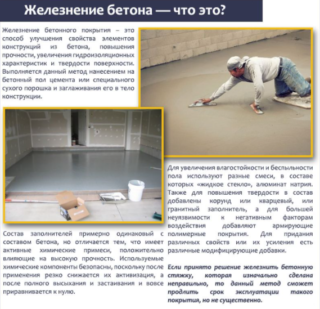








You can protect the made blind area with a simple folk remedy - foam dissolved in simple gasoline. The coating is better than what is listed in this material. Another big plus is that such a coating can be used immediately with the evaporation of gasoline. I will not write about the cheapness of such a tool, because gasoline is everywhere, as well as polystyrene, which is everywhere thrown into the garbage by everyone. Any foam will do, and the one that comes from the packaging and the one that remains from the construction, any, like any gasoline or any other solvent